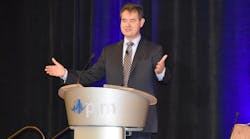PJM Interconnection, the operator of the nation's largest electric grid, conducted its Grid 20/20: Focus on Security & Resilience conference last month to facilitate discussion among electric industry leaders on the role of resilience in electric transmission planning, operations and power markets. Experts discussed cyber and physical security challenges.
"We used to talk about equipment failure and outages caused by storms," said PJM CEO and President Andrew L. Ott. "Now, the threat profile has changed, the considerations are broader. There could be intentional attacks – cyber or physical. Those concerns lead us beyond reliability and into resilience."
PJM held the forum to help define what is meant by resilience, why it is important, and why it is in discussion.
For PJM, Ott said, resilience is the ability of the grid to withstand or bounce back quickly from all events that pose additional operational risks. These risks range from extreme weather to earthquakes, cyber and physical attacks, and events not yet imagined.
The keynote speaker, Paul Stockton, former Assistant Secretary of Defense for Homeland Defense and America's Security Affairs, described a landscape of emerging physical and cyber threats to the electric power system.
Stockton said all of the challenges he put forward illuminate how resilience differs from reliability and why it is increasingly vital. Meanwhile, they offer immediate opportunities for progress and long-term transmission planning.
"We're facing an increasingly severe international environment," he said. "That's all the more reason to care about resilience and, most importantly, build practical steps to strengthen resilience."
Experts representing state governors, transmission companies, regulators, government agencies, and others shared best practices in resilience and deliberated the risks and costs involved.
On one discussion panel, government, military, industry and regulatory speakers emphasized the importance of relationship-building in forming public/private bulwarks against the threat of cyberattacks.
Bill Lawrence, senior director of Electricity Information Sharing and Analysis Center for the North American Electric Reliability Corporation, offered a positive note on information sharing.
"We have much better internal dialogue going on," Lawrence said. "We're not resting easy, but we're not one mouse-click away from the grid going off."
One expert panel focused on how wholesale electricity markets and system operations can benefit resilience and how resilience benefits them. The importance of communication and transparent information sharing was a theme of this discussion, too.
Another panel discussed the roles of transmission line siting, new technologies and information transparency in addressing resilience during the grid planning process.
"We want to assure stakeholders, we are placing more emphasis on actions to take now," said Ott, PJM's CEO. "This is not something that will be solved overnight."
He emphasized that building system resilience is not "gold plating" the system. Resilience solutions have to make sense, be cost-effective with checks and balances, he said.


